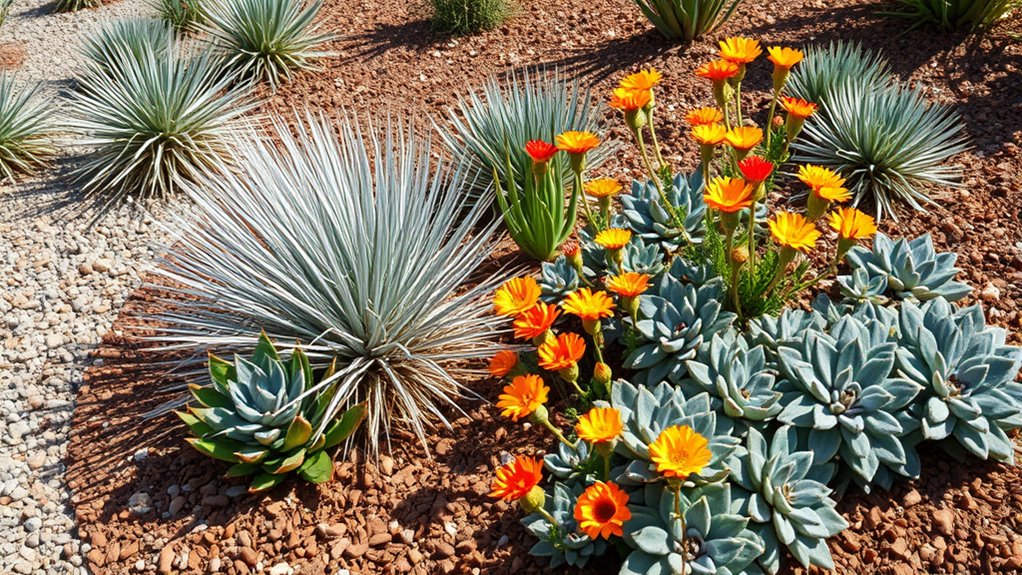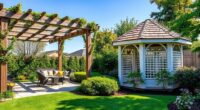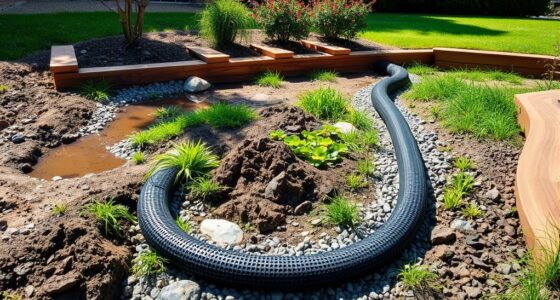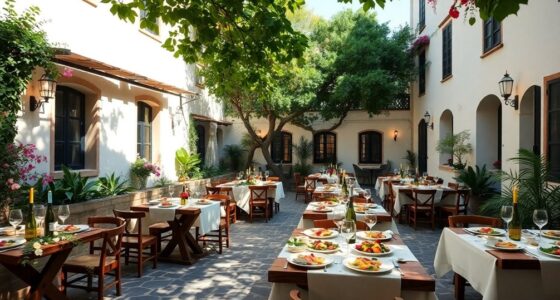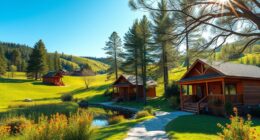To create a drought-proof lawn alternative, you can use native grasses like buffalo or blue grama, or opt for xeriscaping with drought-tolerant plants and efficient watering techniques. Consider replacing traditional turf with succulent or xerophyte gardens, or install artificial turf for low-maintenance greenery. Hardscape features like permeable pavers and gravel gardens also reduce water use and improve stormwater management. Keep exploring to discover more eco-friendly options tailored for your landscape needs.
Key Takeaways
- Use native, drought-tolerant grasses like buffalo grass or blue grama for low-water lawns.
- Implement xeriscaping with drought-resistant plants, mulching, and efficient irrigation to reduce water needs.
- Consider artificial turf for a maintenance-free, green appearance without water or mowing requirements.
- Incorporate permeable paving and hardscape features to improve water infiltration and reduce runoff.
- Opt for gravel or rock landscaping with native, pest-resistant plants for an attractive, low-maintenance drought-proof yard.
Native Grass and Ground Cover Options

Choosing native grasses and ground covers is an effective way to create a drought-resistant lawn. Native grass maintenance is generally simpler because these plants are adapted to your region’s climate and soil conditions. They typically require less water, fertilizer, and mowing compared to traditional turf. When engaging in ground cover planting, focus on species that thrive with minimal irrigation and provide year-round coverage. Options like buffalo grass, blue grama, or creeping sedum can establish quickly and resist drought stress. Proper installation and ongoing care ensure your native grasses and ground covers flourish without extensive watering. Incorporating airless spray technology techniques can streamline the planting process and improve coverage when establishing new ground covers. This approach not only conserves water but also supports local ecosystems, making your landscape sustainable and resilient against dry spells.
Xeriscaping: Water-Wise Landscaping Techniques
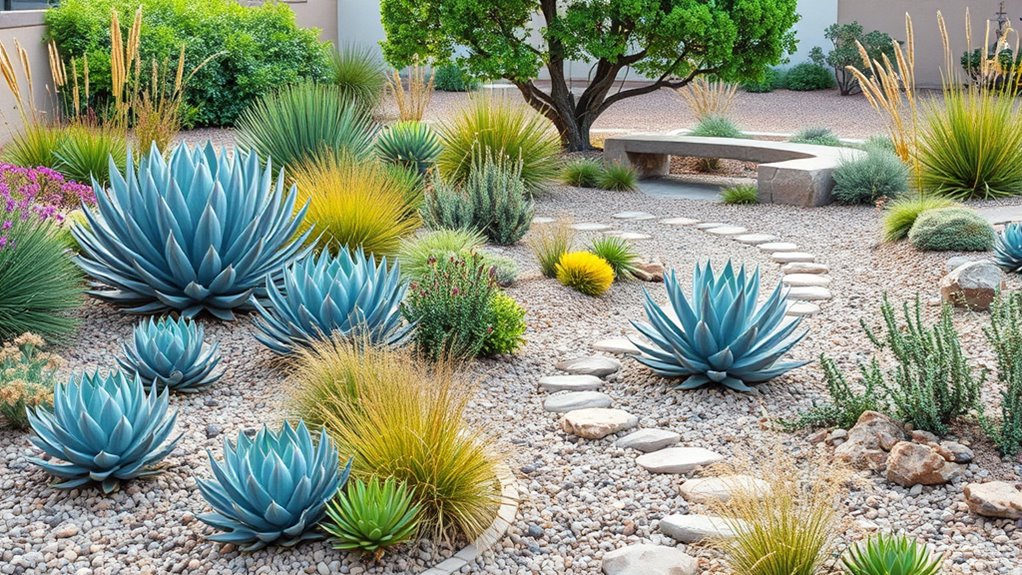
Xeriscaping offers a practical approach to reducing water use in your landscape by incorporating drought-tolerant plants and efficient design principles. You can maximize water savings by using rainwater harvesting systems to capture and direct runoff into your garden. Improving soil health with soil amendment techniques, like adding compost, enhances water retention and plant resilience. Focus on grouping plants with similar water needs to minimize waste. Mulching helps retain moisture and suppress weeds, further conserving water. Here’s a quick overview:
| Technique | Benefit | Example |
|---|---|---|
| Rainwater harvesting | Supplies free, sustainable water for plants | Rain barrels |
| Soil amendments | Improves soil structure and moisture retention | Compost, organic matter |
| Plant grouping | Reduces unnecessary watering | Drought-tolerant native plants |
Additionally, selecting water-efficient plants can significantly reduce water consumption while maintaining a lush landscape.
Drought-Resistant Turf Alternatives

You can choose native grass varieties that thrive with less water and require minimal maintenance. Synthetic turf options offer a green, low-cost alternative that stays perfect year-round. Low-water ground covers also provide an attractive, drought-resistant solution for your lawn needs. Incorporating rustic decor elements can further enhance the natural, drought-proof appearance of your landscape.
Native Grass Varieties
Native grass varieties offer an excellent solution for creating drought-resistant lawns, as they are naturally adapted to local climate conditions and require less water and maintenance. Their native grass characteristics include deep root systems, drought tolerance, and resilience to local pests and diseases. These qualities enable them to survive droughts through effective drought adaptation strategies, reducing your need for supplemental watering. When choosing native grasses, consider species like buffalo grass, blue grama, or buffalo grass, which thrive in arid conditions.
- Deep root systems access underground moisture
- Reduced water needs compared to non-native species
- Low fertilizer and maintenance requirements
- Enhanced resistance to local pests and diseases
Synthetic Turf Options
Synthetic turf options offer a practical and low-maintenance alternative to native grasses for those seeking drought-resistant lawns. These surfaces require minimal garden irrigation, saving water and reducing utility bills. Unlike natural grass, synthetic turf doesn’t depend on soil moisture management, making it ideal for dry regions. It stays green year-round without fertilizer or mowing, which further conserves resources. When installing synthetic turf, consider proper drainage to prevent water pooling and ensure longevity. Although it doesn’t support soil health like natural grass, synthetic turf provides an attractive, durable surface that withstands heavy foot traffic. Its low water requirements make it a smart choice for drought-prone areas, helping you maintain a lush, green appearance without the ongoing need for watering or soil moisture adjustments. Proper installation is essential to maximize the lifespan and performance of synthetic turf.
Low-Water Ground Covers
Low-water ground covers provide an effective and attractive alternative to traditional turf, especially in drought-prone regions. They require less water and maintenance, making them ideal for conserving resources. To maximize their benefits, choose appropriate irrigation methods such as drip systems or soaker hoses that deliver precise, efficient watering. Seasonal planting ensures you select the best ground covers for each climate zone and time of year, promoting healthy growth. When establishing these ground covers, consider the following:
- Use drought-tolerant species suited to your region
- Minimize watering during establishment with efficient irrigation methods
- Mulch to retain moisture and reduce evaporation
- Plan for seasonal planting to optimize growth and resilience
Decorative Gravel and Rock Gardens

Decorative gravel and rock gardens offer an attractive and maintenance-free alternative to traditional lawns, especially in drought-prone areas. You can create a stunning landscape by choosing pest resistant plants that thrive with minimal water and resist pests naturally. These gardens improve soil moisture retention by reducing evaporation, helping your plants stay healthy even during dry spells. Gravel and rocks serve as a durable, low-maintenance ground cover, preventing weed growth and eliminating the need for mowing or watering. You can incorporate colorful stones, larger boulders, or decorative pebbles to add visual interest. Additionally, these gardens require little to no irrigation once established, making them an eco-friendly choice for conserving water and reducing upkeep. Overall, rock gardens provide a practical, drought-tolerant solution that enhances your outdoor space’s beauty.
Xerophyte and Succulent Gardens

Creating a xerophyte and succulent garden is an excellent way to enjoy a lush landscape while conserving water. These gardens thrive on minimal irrigation and add visual interest with unique textures and shapes. When planning your cactus garden design, consider diverse species for color and structure. Use succulent container arrangements to create focal points and add flexibility. Keep in mind:
- Choose plants adapted to your climate
- Use well-draining soil to prevent root rot
- Incorporate decorative rocks for aesthetics and moisture retention
- Group similar plants for easier maintenance
This approach reduces water use and maintenance while providing a striking, drought-tolerant landscape. Whether you opt for a traditional garden or colorful containers, xerophyte and succulent gardens offer a sustainable, eye-catching alternative to traditional lawns.
Artificial Turf and Synthetic Surfaces
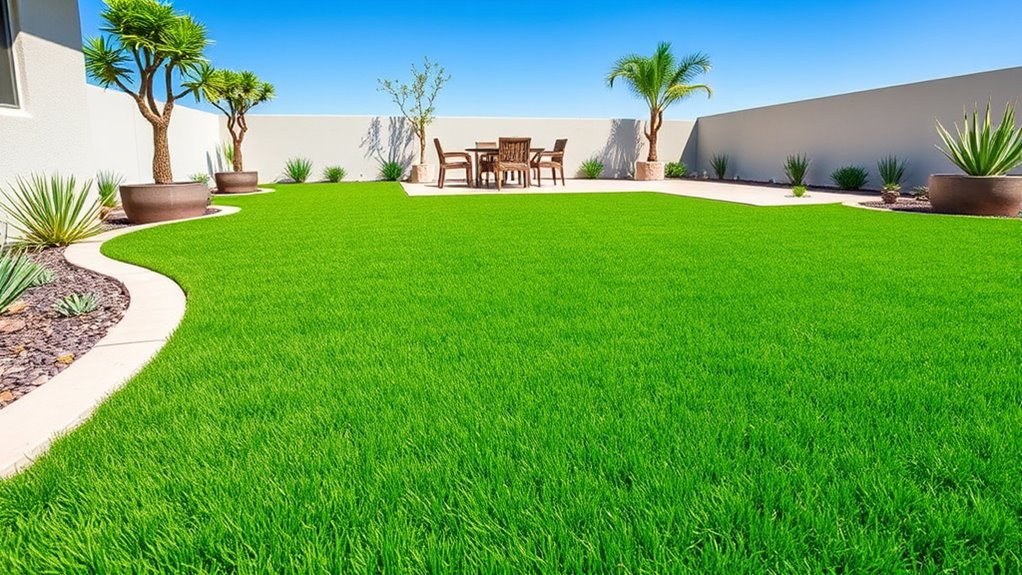
Artificial turf and synthetic surfaces offer a practical alternative to natural grass, especially in drought-prone areas. They require minimal maintenance, saving you time and ongoing costs like watering, fertilizing, and mowing. Although the upfront investment can be high, maintenance costs are considerably lower over time. However, it’s important to contemplate the environmental impact. Synthetic surfaces don’t need water and reduce chemical runoff, but they are made from plastics, which can contribute to plastic waste and microplastic pollution. Additionally, heat retention can make these surfaces hotter than natural grass, affecting their comfort and ecological footprint. Overall, artificial turf provides a durable, low-water option, but weigh the environmental costs and long-term expenses before making your decision. Considering building codes and zoning laws is also essential to ensure compliance with local regulations.
Permeable Paving and Hardscape Features

Permeable paving and hardscape features offer an effective way to reduce runoff and improve water management on your property. By allowing water to seep through surfaces, you can minimize stormwater runoff, prevent erosion, and recharge groundwater. These features also help mitigate urban heat by reducing heat absorption and promoting cooling in paved areas. When choosing permeable options, consider:
- Permeable concrete and pavers
- Gravel or crushed stone surfaces
- Permeable brick patterns
- Green or shaded hardscapes
Using these materials not only enhances stormwater management but also contributes to urban heat mitigation. They create functional, eco-friendly spaces that reduce the need for irrigation and help combat the effects of drought. Integrating permeable hardscapes makes your landscape more sustainable and resilient, especially as water parks continue to adapt to changing climate conditions.
Frequently Asked Questions
How Do Drought-Proof Lawns Impact Local Biodiversity?
You might wonder how drought-proof lawns affect local biodiversity. They often support native pollinators by providing habitat diversity, which is vital for their survival. By reducing water needs, these lawns create stable environments that attract and sustain various species, enhancing overall ecosystem health. You’ll find that replacing traditional lawns with drought-tolerant plants promotes native pollinators and boosts habitat diversity, benefiting local wildlife and fostering a more resilient environment.
Are Drought-Resistant Plants Suitable for Shady Areas?
While some might see shady spots as less ideal, you’ll find that drought-resistant plants with high shade tolerance can thrive there. Carefully selecting plants suited for shade and drought conditions guarantees your garden remains vibrant and sustainable. These resilient choices not only conserve water but also add unique textures and colors to shaded areas. With thoughtful plant selection, you make the most of shady corners, creating a lush, low-maintenance landscape that endures.
What Maintenance Is Required for Xerophyte Gardens?
For xerophyte gardens, you’ll need to focus on proper maintenance. Start with soil preparation by ensuring well-draining soil to prevent root rot. Regular xerophyte pruning helps maintain shape and encourages healthy growth, but avoid over-pruning. Keep an eye on watering; these plants need minimal water, so only water during prolonged dry periods. With these steps, your xerophyte garden stays healthy and resilient with minimal effort.
Can Artificial Turf Increase Urban Heat Island Effects?
Artificial turf can contribute to the urban heat island effect by increasing surface temperatures, as it absorbs and retains more heat than natural grass. This reduces urban cooling, making cities warmer. When you choose artificial turf, you’re potentially worsening heat island issues, especially during hot weather. To mitigate this, consider installing reflective or cooling infill materials, and incorporate more natural shading and green spaces to promote urban cooling.
Are Permeable Pavements Cost-Effective Long-Term Solutions?
Think of permeable pavements as the open gates to sustainable urban landscapes. They’re often cost-effective long-term, but you must weigh the cost analysis against installation challenges, like uneven surfaces or clogging. While initial costs might seem higher, their ability to reduce runoff and recharge groundwater pays off over time. You’ll find that with proper planning, these eco-friendly solutions can turn your project into a resilient, green oasis.
Conclusion
By exploring these drought-proof lawn alternatives, you’re taking vital steps toward a more sustainable landscape. But the real question is, which option will transform your yard into a resilient, water-wise oasis? As you consider each choice, remember that the right decision could change everything—saving water, reducing maintenance, and creating a stunning outdoor space. Are you ready to make that leap and discover the secret to a truly drought-resistant yard?
